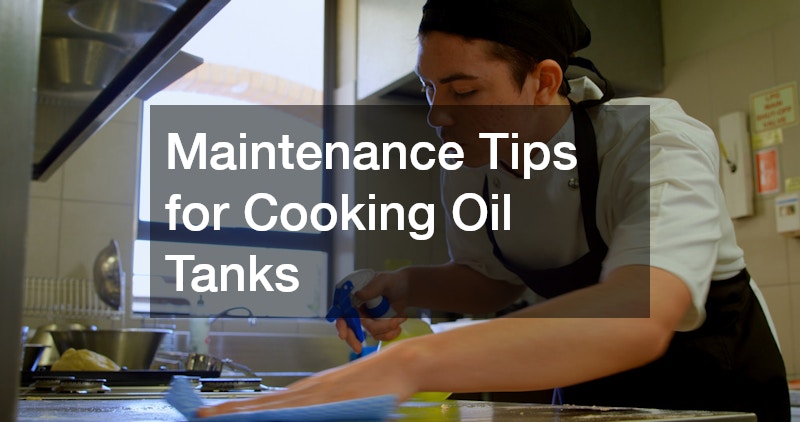In the world of culinary arts and gastronomy, cooking oil is a staple ingredient utilized in various cuisines around the globe. To ensure maximum efficiency, safe storage, and optimal quality, proper management of cooking oil tanks is crucial. This comprehensive guide will delve into the essential aspects of cooking oil tank management, focusing on storage, safety, and maintenance, to help kitchen operators and restaurant owners keep their operations running smoothly.
Understanding Cooking Oil Tank Storage
Proper storage of cooking oil tanks is vital to maintain the quality and longevity of the cooking oil. The first step in ensuring effective storage is to choose the right tank material that prevents contamination and ensures durability. Stainless steel and food-grade polyethylene are commonly used materials that offer excellent protection against corrosion and are easy to clean. Properly sealed lids and airtight containers help prevent oxidation, which can decrease the oil’s shelf life. Additionally, keeping the tank in a cool and dry environment helps prevent the growth of bacteria and degradation of the oil’s quality.
Sizing the cooking oil tank correctly is also critical to effective storage. It is important to assess the daily usage in your kitchen to determine the appropriate tank size that will meet your needs without causing frequent refills. An oversized tank can lead to long periods of oil storage, possibly resulting in deteriorated quality due to prolonged exposure to air. Meanwhile, an undersized tank may require frequent refilling, increasing the risk of contamination each time the tank is opened. Therefore, striking the right balance in tank size is key to maintaining a steady supply of high-quality cooking oil.
Placement of the cooking oil tank within the kitchen or storage area is equally important. It should be positioned in a location that is easily accessible for refilling and cleaning yet away from heat sources like ovens and stoves. Heat can accelerate the degradation of stored cooking oil, leading to the generation of impurities and off-flavors. To facilitate efficient operations, the storage area should also have good ventilation, which will help dissipate any potential odors and keep the oil in optimal condition. Proper labeling and dating of stored oil can further help in tracking usage and ensuring rotation to use older oil before newer stock.
Safety Considerations for Cooking Oil Tanks
Safety is a primary concern when dealing with large quantities of cooking oil in commercial settings. One of the key safety measures is implementing a detailed spill prevention plan to tackle accidental leaks or spills. To ensure a rapid response to any such incidents, it is essential to have spill kits readily available, which include absorbent materials and tools for safe cleanup. Regular inspections of the tank and its components, such as valves and seals, can help identify potential weak points that may result in leaks. Investing in high-quality, durable tanks with safety features like overflow alarms can significantly reduce the risk of accidental spills.
Staff training is also a critical component of cooking oil tank safety. Employees need to be trained on safe handling techniques, emergency protocols, and the proper use of personal protective equipment (PPE) during refilling and maintenance procedures. Maintaining a clean work environment, free from oil drips and residues, minimizes slip and fall risks for employees. Regular training and safety drills ensure that staff members are well-equipped to handle emergencies and minimize potential hazards associated with cooking oil management.
Ventilation and fire prevention measures are additional considerations for maintaining a safe environment around cooking oil tanks. Sufficient ventilation helps disperse any fumes that may arise from heated oil, reducing the risk of ignition and the formation of hazardous vapors. Cooking oil has a high flash point, but maintaining an organized kitchen with clear safety zones around storage sites helps mitigate fire risks. Installing fire suppression systems, such as automatic extinguishers, in areas where oil is stored can provide an extra layer of protection. Regular safety audits conducted by trained professionals can help identify and rectify any compliance issues or safety concerns regarding cooking oil storage.
Maintenance Tips for Cooking Oil Tanks
Routine maintenance is essential to prolong the lifespan of cooking oil tanks and ensure consistent oil quality. Regular cleaning of the tank is crucial to prevent the accumulation of residue and buildup that can affect oil purity. Using warm water and mild detergents, followed by thorough rinsing and drying, safeguards against contamination and odor retention. Depending on usage frequency and environmental factors, an established cleaning and maintenance schedule ensures the tank remains in optimal condition. Implementing a checklist for inspecting key components like gaskets, lids, and valves helps ensure they function correctly and do not contribute to potential leaks or contamination.
Routine testing of cooking oil quality is another critical aspect of maintenance. Testing kits that measure attributes such as free fatty acid content and oxidation levels are readily available and provide insights into the freshness and viability of the stored oil. Consistent monitoring enables operators to make informed decisions on when to replace or recycle old oil, thus maintaining product quality. Some operations may find it beneficial to partner with professional service providers for oil filtration and tank maintenance. Utilizing external expertise ensures comprehensive care and often brings advanced options that are not available in-house.

